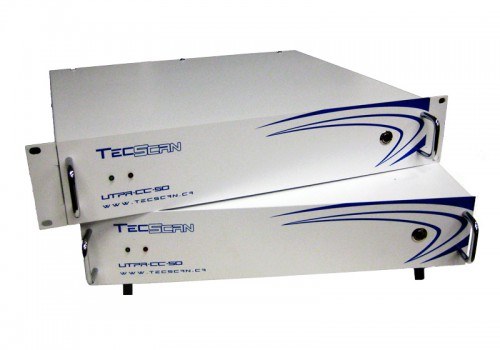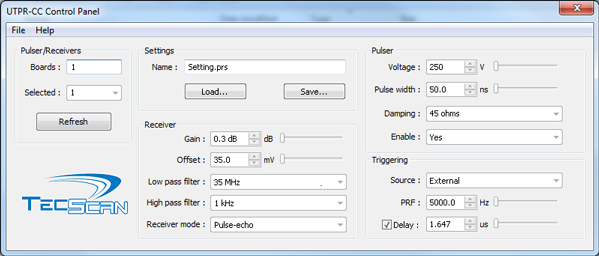Ultrasonic Pulser Receivers
TecScan offers high performance Ultrasonic Pulser Receivers specially designed for demanding NDT scanning applications. Our Pulser-Receivers are used in wide range of applications, aerospace, industrial, manufacturing and laboratory for composite testing of large and thick structures as well as for industrial applications for weld inspection, thickness and corrosion mapping. The NDT instruments are delivered as part of our scanning systems or standalone equipment piloted by an easy-to-use TecView™ NDT software. Quality testing and components testing companies trust our Pulser-Receiver for their amazing flexibility and performance.
High performance USB 2.0 compatible Pulser/Receivers !
Computer controlled Ultrasonic Pulser/Receivers designed for demanding NDT applications.
Pulser/Receivers configurations
Our Pulser/Receivers are high performance and designed for demanding NDT applications with computer control capability. They are USB 2.0 compatable and come in three different configurations:
- UTPR-CC-35: Square Wave Ultrasonic Pulser Receiver
- UTPR-CC-50 : Negative Spike or Square Wave (User selectable)
- ProScan : Standalone Spike or Square Wave with integrated high-speed digitizer
High Flexibility
With a high flexibility in the adjustment of pulse amplitude, pulse width and a set of damping resistors, our Pulser-Receivers accommodate a very wide range of applications and transducer types.
Variable pulse width and fast rise/fall time
Due to the wide range of pulse width and fast rise/fall time, these Pulser can be used to optimize the response of broadband transducers of various frequencies.
Spike & Square wave pulser*
Two available user selectable wave modes provide optimization for wide range of NDT applications and for optimizing the response of broadband transducers of various frequencies.
Receiver with Time-Corrected Gain*
The UTPR-CC 50 Pulser-Receiver comes with Windows® based control panel software with Time-Corrected Gain (TCG) option. It consists of a time-varying gain correction applied based on a DAC curve defined by the user.
Backwall Echo Attenuation (optional)*
Backwall Echo Attenuation (BEA) is a special tool that is only available with dual pulse-receiver hardware. It allows to control the receiver gain independently on different sections of a single A-Scan to avoid saturation while increasing the gain on separate areas of the RF signal.
Reliable and Powerful Pulsers/Receivers
They have rapid recovery receivers which are fully shielded from electromagnetic noise to provide high signal-to-noise ratio output signals. With up to 80dB receiver gain adjustable in 0.1dB increments, variable offset and selectable low and high pass filters, received signals can be optimized with high precision.
Used for NDT applications and more
These Pulser/Receivers are perfectly suitable for application such as flaw detection and thickness gauging, up to material and transducer characterization, computer-controlled measurements and C-Scan imaging and many NDT applications.
Computer controlled via USB
All the Pulser-Receivers come with Windows® based control panel software. A software development kit for Windows® 7 is also provided to easily integrate the functionalities of the pulser/reciver into your software
* Options available with the UTPR-CC-50 & ProScan configurations.
Features & Advantages
- Selectable Spike /Square wave pulser (UTPR-CC-50 configuration)
- Configurable up to 8 cascaded ultrasonic channels
- Independent pulser and receiver on each channel
- Broadband receiver
- Computer controlled (USB 2.0, 3.0)
- High signal-to-noise ratio output
- Receiver supports DAC/TCG & BEA (UTPR-CC-50 configuration)
- Rackmountable
UTPR-CC-35 Pulser-Receiver Specifications:
| Pulser | |
|---|---|
| Pulser type | Negative square wave |
| Pulse amplitude | 50V to 300V (1V steps) |
| Pulse width | 30 to 500 ns (0.1 ns steps) |
| Damping | 500 Ohm, 29 Ohm ,97 Ohm, 78 Ohm, 45 Ohm, 41 Ohm, 33 Ohm, 30 Ohm (8 selectable levels) |
| Rise time | < 5 ns (damping 500 Ohm, pulse width 30 ns, 50 V) |
| Fall time | < 20 ns (damping 500 Ohm, pulse width 500 ns, 300 V) |
| PRF max | 5000 Hz |
| Trigger source | Internal/External |
| Receiver | |
| Gain | 0 to 85 dB (0.1 dB steps) |
| Bandwidth | Broadband: 300 kHz – 60 MHz (-3dB) |
| High-Pass Filters | 300KHz, 500KHz, 1MHz, 2.5MHz, 5MHz and 10MHz (6 selectable level) |
| Low-Pass Filters | Broadband, 35MHz, 25MHz, 15MHz, 10MHz, 5MHz and 2.5MHz ( 7 selectable level) |
| DC offset | -250 to 250 mV (1 mV steps) |
| Noise level | Typically 140µVpp input referred @ 80 dB |
| TT isolation | Typically 90 dB @ 10 MHz |
| TCG | 0 to 46 db |
| Mode configuration | Pulse-echo and Through-transmission |
UTPR-CC-50 Pulser-Receiver Specifications:
| Pulser | |
|---|---|
| Pulser type | Negative Spike or Square wave (User selectable) |
| Pulse amplitude | -50 to -400 V (Spike) and -260V (Square) (1V steps) |
| Pulse width | Spike: Typically 10 to 100 ns (selectable in 8 energy levels) |
| Square: | 25 to 500ns for Square (0.1 ns steps) |
| Damping | 30 W, 33 W, 41 W, 45 W, 78 W, 97 W, 219 W, 500 W (None) |
| Fall time | < 4 ns |
| Rise time (Square) | < 12 ns at 260 V |
| PRF max | 20 kHz (Spike) or 5 kHz (Square) |
| Trigger source | Internal/External |
| Receiver | |
| Gain | 0 to 80 dB (0.1 dB steps) |
| Bandwidth | Broadband: 300 kHz – 60 MHz (-3dB) |
| High-Pass Filters | 300 kHz (None), 500 kHz, 1 MHz, 2.5 MHz, 5 MHz, 10 MHz |
| Low-Pass Filters | 50 MHz (None), 35MHz, 25 MHz, 15 MHz, 10 MHz, 5 MHz, 2.5 MHz |
| DC offset | -250 to 250 mV (1 mV steps) |
| TT isolation | Typically 72 dB @ 10 MHz |
| TCG** | 48 dB (Maximum slope of 12dB/ms, Resolution of 50ns) |
| BEA (optional)*** | 110 dB Attenuation |
| Mode configuration | Pulse-echo and Through-transmission |
** Up to 66 dB with TecScan’s inspection systems and software
*** Only available with TecScan’s inspection systems and software
ProScan Pulser-Receiver Specifications:
| Pulser | |
| Pulser type | Square & Spike (user selectable) |
| Supply voltage | -50V to -300V (1V steps, Square); -50V to -400V (1V steps, Spike) |
| Spike capacitor | 15 selectable levels (Spike) |
| Pulse width | 30 ns to 500 ns (Square; 0.1ns steps) |
| damping | 500 Ohm, 219 Ohm ,97 Ohm, 78 Ohm, 45 Ohm, 41 Ohm, 33 Ohm, 30 Ohm (8 selectable levels) |
| Square fall time (damping 500 Ohm, pulse width 500 ns, 300 V, 50 Ohm load) | 14 ns Typ. |
| Square rise time (damping 500 Ohm, pulse width 500 ns, 300 V, 50 Ohm load) | 4 ns Typ. |
| Spike rise time (damping 500 Ohm, spike capacitor 2270 pf, 400 V, 50 Ohm load) | 4.6 ns Typ. (1.7 ns to 5.3 ns depending on Damping, Capacitor & Voltage) |
| PRF | 5 kHz (Square) & 20 kHz (Spike) |
| Trig source | external/internal |
| Receiver | |
| Gain | -3 to 82 dB |
| Bandwith | 300 kHz to 60 MHz |
| High Pass filter | 300 kHz, 500 kHz, 1 MHz, 2.5 MHz, 5 MHz and 10 MHz (6 selectable level) |
| Low Pass | Broadband (60 MHz), 35 MHz, 25 MHz, 15 MHz, 10 MHz, 5 MHz and 2.5 MHz (7 selectable level) |
| DC offset | -250 mV to 250 mV (1 mV step) |
| Noise | Typically 200 mVpp input referred |
| TT isolation | Typically 95 dB @ 10 MHz |
| TCG | 0 to 46 dB |
| mode config | pulse-echo or through-transmission |
| Digitizer | |
| Resolution | 8 or 12 bit (Selectable) |
| Maximum sampling rate | 125MHz |
| IOs | Trigger input (TTL), Trigger out (5V), Ext. clock input |
| Input impedance | 50 Ohm, 1MOhm |
| Input coupling | DC, AC |
| Full scale input | ±10V, ±5V, ±4V, ±2V, ±1V, ±500mV, ±400mV, ±200mV |
| Data transfer | High speed USB (Transfer Rate up to 40 Mb/s) |
| Transfer while recording | Yes |
| Encoder Input | 2 axis (Quadrature) |







